#marsha m linehan
Photo
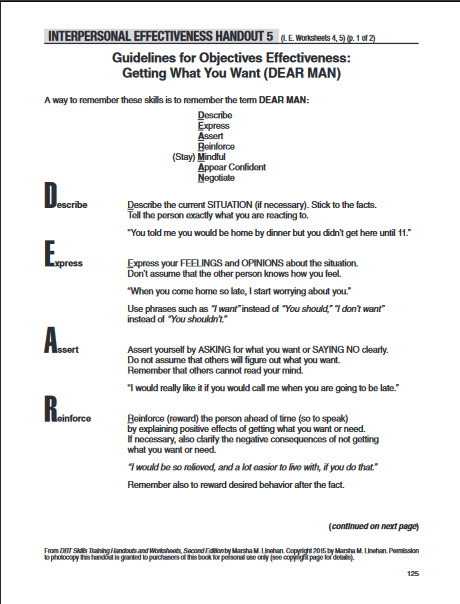
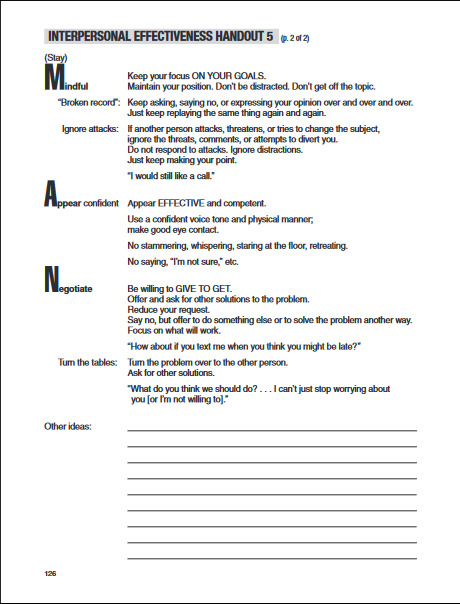

DEARMAN, interpersonal effectiveness skill
Describe the situation,
Express your feelings and opinions,
Assert yourself by asking or saying no,
Reinforce & reward desired behaviour,
stay Mindful of your goals,
Appear confident and gently forceful,
Negotiate and compromise
- From DBT Skills Training, Handouts and Worksheets by Marsha M. Linehan
#dogpost#dbt#dbt skills training#marsha m linehan#undescribed#dearman#brought to you by therapy today lol
45 notes
·
View notes
Photo

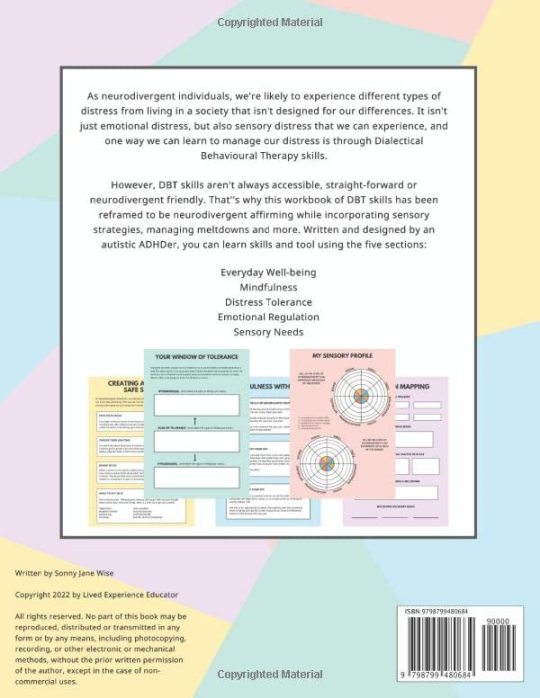
Question: Does anyone have experience with this workbook so far?
I’m thinking of buying it someday as I’m neurodivergent but it’s price is driving me away as the amount of pages in the workbook are quite little. € 24,85 for only 79 pages is something that makes me feel like I’m being ripped off to be fair, but I don’t want to sound mean...
It looks really good but the price to page ratio is just making me very unsure. I also found out it has spelling mistakes so,,, idk. Calling Marsha Linehan “Marsha Lineham” is kinda funny but also like WHOOPS.
For those that didn’t know this book existed: I found it on amazon! If you don’t have worries about money feel free to buy this book and tell us about it bc I really want to know what it’s truly like.
#dbt#dbt skills#dbtumblr#dialectical behavior therapy#dialectical behaviour therapy#marsha m linehan#marsha linehan#actually neurodivergent#neurodivergency#bpd#borderline personality disorder#actuallybpd#actuallyautistic#actually adhd#adhd#autism
23 notes
·
View notes
Text
i survived another DBT skills class. eating my emotional health vegetables or whatever
6 notes
·
View notes
Photo
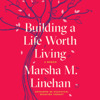
Building a Life Worth Living: A Memoir (Unabridged) - Marsha M. Linehan https://ift.tt/2Mmazw9
2 notes
·
View notes
Photo

The relationship between emotion dysregulation and borderline behavior patterns, according to the biosocial theory.
Marsha M. Linehan, Cognitive-Behavioral Treatment of Borderline Personality Disorder
150 notes
·
View notes
Text
Whats up gamers its me WimpCritic186 here, and welcome to yet another viral Minecraft video. Are you suffering? Are you tired of the tedious march through the morass of grief and heartache life has handed you? Have you heard it said one too many times that the "only way out" is "through"? Well.
In today's redstone tutorial, I will show you how to build what I'm calling the "emotional helicopter", a server-friendly, slime-block-powered redstone contraption I've devised for the express purpose of lifting you up and around difficult emotional barriers in your life without the hassle of actually "processing" your "shit". Don't forget to "Like" this video.
Coming up, I'l test this simple and compact device on two of my friends and fellow DVorceCraft SMP members, Neomilk and banal_lad, who, as you might know, just went through a messy, extremely public breakup. Will Milk and Lad find closure, or will they be caught in the blades? Can 1,600 pistons do what 72 hours of couples-counseling livestreamed over tiktok failed to? And how exactly can a single zombie pigman and an obscure quirk of Minecraft Java's lighting engine combine to form the perfect backdoor into what American psychologist Marsha M. Linehan refers to as the "Wise Mind" in her acclaimed Dialectical Behavioral Therapy framework? Stay tuned for all of this and more, but first, let me take a moment to tell you about Ziploc.
I, WimpCritic186, am thrilled to announce that Ziploc is the sponsor of today's technical minecraft video. Ziploc is a special bag that is extremely pog and goated. As a full time content creator, I have to stay mad organized, and I love using reusable Ziplocbags to store my various gamer items and gamer substances.
Let's talk history. Originally developed and test marketed by The Dow Chemical Company in 1968, Ziploc is an undeniable icon in the crowded sliding-channel-storage-bag market-space, standing head and shoulders above competitors like Glad and Hefty in terms of name recognition and brand loyalty – but it wasn't always that way.
The year is 1951. Danish Inventor Borge Madsen submits a patent application for a new type of plastic slide fastener. Enter businessman and innovator Steven Ausnit. Now, Steven was born in Romania in 1924. His father was Max Ausnit, then regarded as the "The Steel King" of Romania – at least until the fateful day an industry rival falsely accused him of a crime he did not commit, leading to his wrongful conviction and imprisonment. During World War II, after successfully escaping house arrest, … Click To Continue
34 notes
·
View notes
Note
I think the last reblog is referring to DBT -- a therapy practice that (iirc) focuses on functioning in the present moment and coping skills. I'm just not sure who exactly they're referring to, and not in the right search tab to google it immediately.
Oh, I was kidding. Marsha M. Linehan is the psychologist who created DBT.
4 notes
·
View notes
Text
Dialectical Behavior Therapy
DBT is a skills-based therapy derived from CBT (Cognitive Behavior Therapy). Both are effective in treating BPD.
DBT is centered around 4 focused approaches: Mindfulness, Emotion Regulation, Distress Tolerance and Interpersonal Effectiveness. Each module has a breakdown of skills for how to replace negative coping mechanisms developed over one’s life with healthier, positive ones. My favorite is the STOP skill (Stop, Take a step back, Observe, Proceed mindfully). This has been incredibly helpful in keeping me from splitting and has reduced my episodes by about 50%. Skills become second nature with continued use.
DBT is done in both group and individual settings, and you can find Comprehensive DBT programs that offer both group/individual as well as 24/7 access to your individual therapist for skills coaching in crisis moments. It is usually covered by insurance.
If it is not covered by your insurance, there are workbooks, handbooks and flash cards readily available online!
Cited source
My favorite DBT workbook!
My favorite DBT flashcards!
Marsha M. Linehan's Original Handbook
22 notes
·
View notes
Text
TAG PEOPLE YOU WANT TO GET TO KNOW BETTER!
favorite colour: shades of green and blue! especially teal, deep forest green, very light blue. it varies, but generally some shade of green or blue is the very favourite.
currently reading: a game of thrones by george r. r. martin (finally! never read asoiaf before! super enjoying) and building a life worth living by marsha m. linehan (the autobiography of the person who developed dialectical behavioural therapy, as recommended by my partner, who has bpd; also enjoying!)
last song: i have no idea, i rarely listen to music!
last series: watching the boys, on season 2 now, immensely enjoying it. also recently finished our flag means death which was absolutely phenomenal.
last movie: uhhhh... i don’t remember, sorry lol.
sweet / spicy / savory: sweet definitely, savory is also good. i’m autistic and have sensory issues with spicy, it literally just... hurts.
currently working on: in theory, writing roleplay responses, and my muse pages, and moving shepard to a single muse blog. learning math. cleaning my apartment. in practice, binge gaming the trilogy.
Tagged by: @virmireisms (thank you!!!!)
Tagging: @starfalled @batteredoptimist @innerwar @feybled @11thdoc @collidingxworlds @voxvulgi & steal it from me!
3 notes
·
View notes
Link
anyway, this article was published at a time when i wanted to do myself immense harm, and when i read it eleven years ago, it was both triggering and a beacon of hope to me. i sometimes revisit it to marvel at martha linehan’s work and to also remind myself of how far i’ve come.
#i also have to laugh#i'm trying not to sound like an evangelical#and in this article martha recounts a religious awakening she had that changed her mental health for the better LOL#anyway please read!
1 note
·
View note
Text
marsha m. linehan save me
1 note
·
View note
Photo

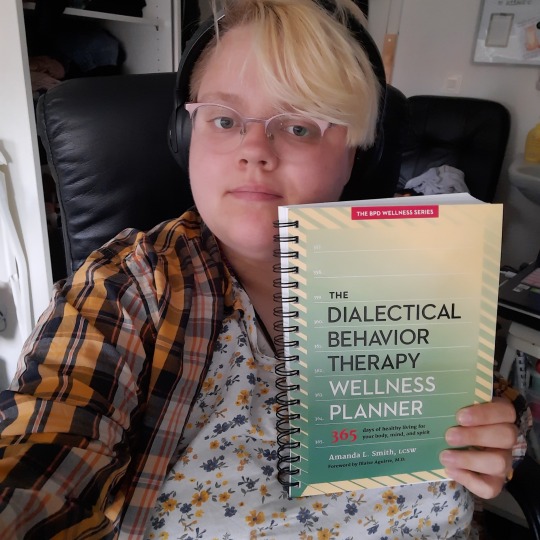
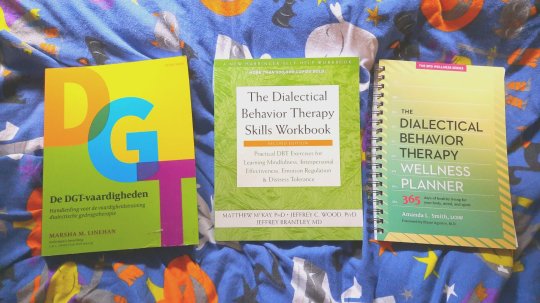
Very excited to be working on my DBT skills again : )
I got my two new DBT books in a few days ago, and I’ve already started with the DBT skills workbook. The Wellness Planner I’ll start tomorrow (monday) and the Dutch DGT-vaardigheden book was my original book that I used during my actual treatment.
My actual goal is to collect more DBT content:
- DBT Skills Training Manual by
Marsha M. Linehan
- DBT Skills Training Handouts and Worksheets, Second Edition by Marsha M. Linehan
- Dialectical Behavior Therapy Diary: Monitoring Your Emotional Regulation Day by Day by Matthew McKay and Jeffrey C. Wood
- Mindfulness for Borderline Personality Disorder by Blaise Aguirre
Dutch books:
- De DGT-Vaardigheden Werkboeken by Marsha M. Linehan
- Omgaan Met Overweldigende Emoties by Matthew McKay and Jeffrey C. Wood
Why would I ever want to learn DBT in English when I finished treatment in Dutch? Because I think it’s interesting to learn it in English, as well as I think I can help more people by knowing everything in English. I also just think it’s fun, the differences between the languages and the way skills are called is really interesting.
#dbt skills#dbt therapy#dbt#dbtumblr#dialectical behavior therapy#dialectical behaviour therapy#actuallybpd#marsha m linehan#lucas.png
11 notes
·
View notes
Text
A Comprehensive Approach to Emotional and Academic Growth in New York City
In the heart of New York City, an innovative approach is transforming the landscape of education and therapy. Amidst the bustling city life, individuals and families are finding solace and strength through Dialectical Behavior Therapy (DBT), a therapy designed to promote emotional and psychological well-being.

This method, along with specialized educational programs, is addressing the complex needs of those facing emotional challenges, especially within the New York area's special education schools. This comprehensive approach is not just about addressing current issues but is deeply rooted in a philosophy of education curriculum that values rigorous academic and social-emotional learning.
The Essence of Dialectical Behavior Therapy
Dialectical Behavior Therapy, developed by psychologist Marsha M. Linehan in the late 1980s, is a cognitive-behavioral treatment that emphasizes individual psychotherapy and group skills training classes to help people learn and use new skills and strategies to develop a life that they experience as worth living. In NYC, DBT therapy has become a beacon of hope for many, offering tools to manage painful emotions and decrease conflict in relationships.
The Role of Dialectical Behavior Therapists in New York
Dialectical Behavior Therapists in New York are at the forefront of this therapeutic revolution. With a deep understanding of the emotional and psychological challenges that individuals face, these therapists tailor their approaches to meet the unique needs of each person, fostering an environment of growth, learning, and emotional resilience.
Academic Rigor and Emotional Growth: A Dual Approach
The notion of rigorous academics in NYC is evolving. Today, it encompasses not only the pursuit of academic excellence but also the cultivation of social and emotional skills. Rigorous education in NYC now signifies a curriculum that challenges students intellectually while supporting their emotional and social development, preparing them for the complexities of the world beyond the classroom.
Special Education and Therapeutic Support in New York
New York is home to several special education schools and therapeutic boarding schools that cater to students with diverse learning needs, including those requiring more specialized therapeutic support. These institutions understand that education is not one-size-fits-all and that some students thrive in environments that offer tailored support, therapeutic interventions, and a focus on social-emotional learning.
Embracing Social Emotional Learning in NYC Schools
Social emotional learning programs for schools in NYC are pivotal in helping students develop essential life skills such as self-awareness, self-control, and interpersonal skills. These programs are integrated into the curriculum to ensure that students not only excel academically but also understand and manage their emotions, feel and show empathy for others, establish positive relationships, and make responsible decisions.
The Impact on Special Needs Education
For special needs schools in NYC, the integration of DBT and social-emotional learning into their programs marks a significant advancement in special education. These schools are dedicated to providing a safe, nurturing, and academically stimulating environment for students with diverse learning needs, ensuring they receive both the emotional support and the rigorous education they deserve.
Therapeutic Boarding Schools: A Haven for Growth
Therapeutic boarding schools in New York offer a unique setting for students who benefit from a more immersive therapeutic and educational experience. These schools combine rigorous academics with comprehensive therapy, social-emotional learning, and life skills training, providing a holistic approach to student development.
In New York City, the convergence of DBT, specialized education, and social-emotional learning represents a forward-thinking approach to addressing the multifaceted needs of individuals facing emotional challenges. Through rigorous academics and a nurturing therapeutic environment, students are empowered to overcome obstacles, build resilience, and pursue a path of growth and success. This comprehensive model not only educates but heals, offering a beacon of hope and a roadmap for a brighter future.
For more information visit website:-
The Gamut School
Gamut School
1 note
·
View note
Text
Dialectical Behavior Therapy Demystified- Managing Emotional Turbulence
Dialectical Behavior Therapy, or DBT, serves as a guiding light for those navigating the stormy seas of emotional turbulence. Rooted in cognitive-behavioral techniques, this approach goes beyond conventional therapy by incorporating mindfulness, acceptance, and interpersonal effectiveness. Its multifaceted nature makes it a comprehensive framework for managing intense emotions and fostering a balanced life.
The therapeutic technique employed by Dr. Heidi Kling comprehensively targets a broad spectrum of emotional instability issues. This approach is not exclusively designed for individuals battling mood-related disorders such as borderline personality disorder (BPD). Instead, it also offers a lifeline to those struggling with a wide range of other mental health challenges, including anxiety disorders, depression, issues of substance abuse, and eating disorders. Originally conceived by Dr. Marsha M. Linehan, this unique methodology elegantly combines the insights drawn from Eastern mindfulness practices with the empirical rigor that characterizes Western psychological science. The ultimate goal of this therapeutic intervention is to equip individuals with coping mechanisms that allow them to manage their emotional distress in a healthy, adaptive manner, and to promote self-reflection that prevents the recurrence of these problems in the future.
The cornerstone of this approach lies in its four modules: mindfulness, distress tolerance, emotion regulation, and interpersonal effectiveness. Mindfulness, the practice of being present in the moment without judgment, stands at the center of this therapeutic paradigm. It cultivates awareness, allowing individuals to observe their thoughts and emotions impartially. By fostering this nonjudgmental stance, it empowers individuals to detach from overwhelming emotions, paving the way for rational responses.
Acknowledging distress and acquiring the tools to effectively endure and manage it is a key component of therapeutic work. Dr. Heidi Kling emphasizes the importance of 'distress tolerance,' a coping mechanism that provides individuals with the ability to navigate crises without resorting to impulsive actions that could exacerbate their distress. This module underscores the acceptance of the realities we face, even those that are difficult or seemingly insurmountable, and the application of practical strategies to manage distress. By internalizing the principle of 'radical acceptance,' clients learn to recognize and adjust to circumstances beyond their control, thereby reducing the potential for emotional turmoil. This not only aids immediate distress management, but also provides a framework for maintaining emotional equilibrium in future crises situations.
Emotion regulation, the third module, delves into understanding, experiencing, and modulating emotions effectively. It educates individuals on identifying and labeling emotions, pinpointing their triggers, and altering their emotional responses through adaptive coping strategies. This module is instrumental in breaking the cycle of emotional reactivity, fostering resilience in the face of challenging circumstances.
Interpersonal effectiveness, the final module, focuses on enhancing communication skills, setting boundaries, and navigating relationships adeptly. It equips individuals with assertiveness training, teaching them how to articulate their needs while respecting others' boundaries. By honing these interpersonal skills, this therapeutic approach fosters healthier and more fulfilling connections, crucial for overall emotional well-being.
Central to the success of this approach is the therapeutic relationship between the individual and the therapist. The therapist assumes the role of a guide, employing validation, empathy, and a nonjudgmental stance to facilitate the individual's growth. Through a blend of individual therapy, group sessions, phone coaching, and skill-building exercises, this approach fosters a supportive environment conducive to emotional healing.
What distinguishes this approach from conventional therapies is its synthesis of acceptance and change-oriented strategies. Unlike traditional cognitive-behavioral approaches that solely emphasize change, this approach recognizes the significance of accepting oneself and the current reality. It advocates for embracing paradoxes and finding a balance between acceptance and change, fostering a dialectical perspective.
The dialectical philosophy underlying this approach encourages individuals to hold seemingly contradictory truths simultaneously. It encourages acknowledging one's flaws while striving for improvement, embracing both vulnerability and strength. This dialectical approach cultivates resilience, enabling individuals to navigate life's complexities with greater adaptability and grace.
The versatility and adaptability of its application extend beyond its initial intended use for treating patients with borderline personality disorder. This adaptability opens up opportunities for its use with a broad spectrum of populations, including different age demographics and various mental health conditions. The effectiveness of this approach, as affirmed through extensive research, is significant in multiple ways. It has been shown to significantly reduce instances of suicidal behaviors, an achievement that cannot be understated. Concurrently, it plays an integral role in improving emotional regulation among patients, allowing them to better manage their feelings and reactions. Lastly, but certainly not least, it contributes to enhancing the overall quality of life for patients. Experienced professionals in the field, like Dr. Heidi Kling, continually employ this method due to its far-reaching positive impacts.
In the realm of therapy, the approach practiced by Dr. Heidi Kling psychologist, a seasoned clinical psychologist with over 25 years of experience, undeniably yields efficacy. However, success in such a therapeutic technique requires a deep-seated commitment and a steadfast will to persevere. Dr. Heidi Kling's method, which is fundamentally skill-based, necessitates consistent effort and dedicated practice outside of the therapy sessions she conducts. Achieving mastery over these integral skills is not a task to be taken lightly. It requires an ample measure of patience and an unwavering persistence. Nevertheless, the rewards for such dedication are profound and life-altering. Through the therapeutic journey with Dr. Kling, patients can anticipate a life marked by a balanced emotional state and fortified coping mechanisms.
This approach demystifies the labyrinth of emotional turbulence by offering a structured roadmap to navigate the complexities of human emotions. It doesn't promise a quick fix but empowers individuals with invaluable tools to foster emotional resilience. By amalgamating mindfulness, distress tolerance, emotion regulation, and interpersonal effectiveness, it stands as a beacon of hope for those seeking to reclaim control over their emotions and lead a more harmonious life.
0 notes
Text
Enhancing Emotional Well-being: Exploring the Benefits of DBT Group Therapy in NYC
Introduction :
In the bustling metropolis of New York City, where the demands of daily life can be overwhelming, individuals seeking support for emotional well-being often turn to various therapeutic approaches. Among these approaches, Dialectical Behavior Therapy (DBT) Group Therapy has emerged as an effective and empowering option. This article delves into the benefits of DBT Group Therapy in NYC, shedding light on how it can help individuals navigate life's challenges and cultivate emotional resilience.
Understanding DBT Group Therapy:
Dialectical Behavior Therapy, developed by psychologist Marsha M. Linehan, is a comprehensive evidence-based treatment designed to help individuals struggling with emotional regulation, interpersonal difficulties, and self-destructive behaviors. DBT combines elements of cognitive-behavioral therapy with Eastern mindfulness practices, emphasizing skills training and acceptance of emotions. In a group therapy setting, participants learn and practice skills such as emotion regulation, distress tolerance, interpersonal effectiveness, and mindfulness.
The Supportive Power of Group Therapy:
Group therapy offers a unique and powerful environment for individuals seeking emotional healing. In a DBT group, participants engage in a safe, non-judgmental space where they can share their experiences, learn from others, and receive validation. Group members form a supportive community, understanding the challenges faced by one another and providing encouragement and empathy. This sense of connection and camaraderie fosters a collective strength that empowers individuals to confront their difficulties and work towards positive change.
Benefits of DBT Group Therapy in NYC :
DBT Group Therapy in NYC offers several significant benefits to participants. Firstly, the group setting provides a cost-effective alternative to individual therapy, making it more accessible to a wider range of individuals. Additionally, the structured nature of DBT skills training allows participants to develop practical tools for managing emotions and navigating challenging situations effectively. These skills are particularly valuable in a fast-paced city like NYC, where stressors abound.
Moreover, DBT Group Therapy fosters a sense of belonging and reduces feelings of isolation commonly experienced by those struggling with emotional difficulties. The group dynamic enables individuals to learn from others' experiences, gain insights into their own patterns of thinking and behavior, and receive constructive feedback. The supportive nature of the group cultivates a sense of accountability and motivation to practice new skills outside of therapy sessions.
Furthermore, DBT Group Therapy in NYC is facilitated by skilled and trained therapists who provide guidance, structure, and expertise. Therapists utilize evidence-based techniques, such as validation and behavior chain analysis, to help group members gain a deeper understanding of their emotions and behaviors. The therapists' expertise, combined with the group's collective wisdom, creates a nurturing and transformative environment that supports personal growth and emotional well-being.
Conclusion:
DBT Group Therapy in NYC offers a transformative path towards emotional well-being for individuals navigating the challenges of a bustling city. Through a combination of skills training, group support, and professional guidance, participants can develop resilience, enhance emotional regulation, and foster healthier interpersonal relationships. Embracing the power of DBT Group Therapy can be a vital step towards a more fulfilling and balanced life
For more info :-
Dbt Group Therapy Nyc
0 notes
Text
Hallo mein Name ist Johanna und ich möchte in diesem Blog die Psychische Erkrankung Borderline Persönlichkeitsstörung genauer erklären und betroffenen Tipps und anregungen geben wie sie sich in einer akuten Kriesensituation sofort selber kurzfristig helfen können.
Ich bin 30 Jahre alt und leide seit meinem 18. Lebensjahr an einer Borderline Persönlichkeitsstörung. Es war ein langer Weg bis ich gelernt habe meine Erkrankung zu akzeptieren und damit umzugehen. Ich habe mich 9 Jahre selbst verletzt. 4 Jahre nach beginn meiner Erkrankung habe ich mich erstmals getraut Hilfe anzunehmen und bin stationär in einer Tagesklinik gegangen. Dort habe ich das erste Mal von dem DBT (Dialektich-Behaviorale Therapie) von Marsha M. Linehan gehört. Ich möchte euch diese Vorm der Verhaltenstherapie nun etwas genauer erklären.
In dieser Therapieform geht es darum, innerlichen Schmerz nach außen zu bringen ohne sich dabei so zu verletzen, dass bleibende Narben entstehen oder Wunden bleiben. Es können alle möglichen Schmerzreize aktiviert werden brennen, stechen, geschmaksreize bitter sauer scharf usw. du kannst diese Reize auslösen durch scharfe Chillischoten, saure Brausebonbons, Kühlspray für die Haut, Gumibänder für das Handgelenk. Dies sind nur einige wenige Beispiele von vielen ich werde dazu noch eine Liste anhängen mit weiteren Skills.
Es gibt im DBT eine sogenannte Anspannungsskala von 0 bis 100 am besten unterteilt man Sie immer in 10 er schritten 10 20 30 usw. daran messt ihr eure Anspannung. Die ganze Skala wird in 4 Stufen unterteilt. 0-30 ist niedrige Anspannung 30-50 ist mittlere Anspannung 50-70 ist hohe Anspannung und 70-100 ist sehr hohe Anspannung.
nun möchte ich euch zeigen welche fertigkeiten (Skills) euch bei welchem anspannungsgrad helfn könnte.
Bei 0-30 können Skills helfen wie z.b.: lesen, Kreuzworträtsel, malen, schreiben, konzentrationsspiele usw.
Bei 30-50 können Skills helfen wie z.b. über steine Laufen, über nasses Gras laufen, Eiswürfel lutschen, saure Bonbons essen usw.
Bei 50-70 können Skills helfen wie z.b. kalt dushen, Brennesseln auf die Haut reiben, Eis spray, Verband mit Vinalgon salbe (bekommt ihr in jeder Apotheke), Chillisauce, Chillishoten, kühl Packs.(bekommt ihr in jeder Drogerie).
Bei 70-100 können Skills helfen wie z.b. Ammonjack Ampullen(bekommt man ebenfals in jeder Apotheke), die allerdings in den meisten Fällen von einer anderen Person gebrochen und einem unter die Nase gehalten werden soll, da man meistens in diesem anspannungsbereich nicht mehr ansprechbahr ist und auch in seiner Umgebung nichts mehr mit bekommt.
Diesen Zustand wenn man nichts mehr mitbekommt und auch nichts fühlt und hört nennt man dissoziation. In meinem nächsten Abschnitt möchte ich euch die Dissoziation etwas genauer erklären.
Unter einer Dissoziation verteht man einen Zustand, in dem die Person gedanklich in einer Sitotiation oder einem Wort hängen bleibt. Äußerich zeigt sich der Zustand, dass die Person starr auf eine Stelle einen Punkt oder eine Richtung starrt, sie bekommt nicht mehr mit, was in der Realität um sie herum passiert. Sie reagiert nicht, wenn Sie angesprochen wird oder auf äußeren Lärm. Man sollte es absolut vermeiden die Person an zu fassen, du kannst dir die Situation so vostellen, als ob du schläfst und dich im Schlaf jemand schüttelt. Die Person kann so erschrecken, dass Sie im schlimmsten Fall schreit und um sich schlägt. Am besten man versucht laute Geräusche zu erzeugen wie Türen knallen etwas schwehres fallen lassen oder die Person an zu schreien.
Ich hoffe ich konnte dir mit meiner Seite etwas weiterhelfen und du konntest vielleicht etwas finden was dir ein bisschen hilft die Zeit zu überbrücken bis du einen Arzt aufsuchen kannst.
bei Akuten Suizidgedanken wenn dir meine Skills nicht weiter helfen sollten findest du alle möglichen Nummern und Adressen für Hilfe bei suizidgefahr im Internet.
Ich wünsche Dir von Herzen viel Kraft um die schwierige Situation möglichst gut zu überstehen.
Alles liebe
Johanna
1 note
·
View note